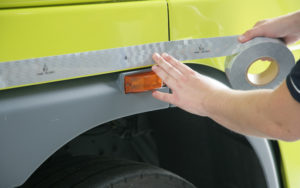When buying reflective chevron products, there are certain factors to consider. From regulations to durability, understanding the differences in products will ultimately ensure you maintain the highest safety standards when driving fleet vans, lorries and larger vehicles.
In this article, we provide an overview of reflective chevron products to help you filter through the noise and find the most suitable products for your requirements.
If you need help when buying reflective vehicle vinyl or tape, simply get in touch with our expert team here at Lakeside Group. We can guide you through the whole process and help you get set up in next to no time.
Tips for buying reflective chevron markings
Chapter 8
When researching reflective chevron products and markings, you may come across the term “Chapter 8”. Chapter 8 is the UK code of practice outlined by the Department of Transport. Although not law, these regulations are certainly worth following and failure to do so could lead to legal ramifications should an accident occur involving your fleet.
Chapter 8 regulations are designed for vehicles stopping or carrying out work on roads and highways. Having clear chevron markings are a key component of being compliant.
The purpose of these regulations is to ensure other drivers, pedestrians or cyclists can clearly see any potential obstruction on the roads, reducing the risk of an accident.
Our recent blog details everything you need to know about Chapter 8 and the types of reflective markings suitable. If you are looking for Chapter 8 compliant vehicle markings, our team can help guide you through our catalogue of dedicated products.
Chevron coverage
Chapter 8 recommends covering as much of the rear of the vehicle as possible, without obscuring windows, lights or registration plates. A large van with no rear windows may have most of the rear end covered in reflective material, while a car will likely have a smaller surface to cover due to the size of the vehicle and the need to keep the back window clear. As a result, the vehicle manufacturer and model will likely impact the installation of any reflective material and the overall appearance.
There should also be consideration to the inside surfaces of rear doors and equipment on the vehicle, to ensure these also have appropriate reflective markings when open.
It is always worth seeking professional assistance and advice to ensure you comply with chevron requirements for your specific vehicles.
Type
There are different ways to create reflective materials. Glass bead, Micro Prismatic and fluorescent products all come with unique benefits and our team here at Lakeside Group can guide you through which type of reflective material best suits your requirements and vehicles.
Different grades help categorise products based on their overall performance and durability.
We stock entry level engineering grade (R1) up to high grade R2 and R3B products. Our R3B range includes a variety of high quality micro-prismatic grade materials such as Avery T6508, Aura 191 and Avery V8000-C8.
Colours
Chevron markings should be alternating yellow and red stripes. The red stripes should be retroreflective for nighttime visibility and the yellow stripes non-reflective fluorescent for daytime visibility.
These chevron markings should point upwards at an angle between 45-60 and be at least 150mm wide.
Side markings
Some vehicles may also require side markings to stay compliant. Specialist contour tape helps to further improve vehicle visibility. If a vehicle is not a conspicuous colour (i.e. yellow or white), Chapter 8 requires a 50mm side marking using yellow micro-prismatic material running the length of the vehicle. This furthers the vehicles’ visibility to other drivers.
ECE 104 outlines that large vehicles weighing over 7.5 tonnes should use rear and side markings to create a clear outline to help aid visibility. We offer a complete line of films for fleet graphics and conspicuity tapes, designed for easy vehicle detection at dawn, dusk and night. Our products are ideal for a variety of applications including fleet vehicles, school buses, farm implements and slow-moving vehicles.
Learn more about our ECE 104 Contour Tape.
Equipment
It is also worth considering any use of temporary traffic signage or street furniture. If these are being used on the road, they should also meet all product recommendations for road signs.
This equipment can be useful in all sorts of situations and for certain organisations, a vital addition to their roadside checklist.
Vehicle branding
As well as official chevron markings and contour tape, reflective graphics that depict your brand and organisation can also be used on the side and front of your vehicle.
Branding commercial vehicles brings with it an array of benefits, including increased brand awareness, professionalism and an effective theft deterrent. By using reflective film, not only can these graphics help showcase your brand on the roads but also help add visibility, helping to improve safety.
Branding a vehicle is a quick and easy job, vinyl wraps or even magnetic strips allow businesses of any size to get vehicle branding installed quickly and affordably.
Our blog delves into everything you need to know about branding commercial fleet vehicles.
Get Started with Lakeside Group
If you would like to learn more about chevron markings, simply get in touch with our expert team here at Lakeside Group to get started.
From standard vehicles to bespoke chevron requirements, we are perfectly positioned to help you get the most out of the very best products on the market.
Our vehicle safety product range includes vehicle markings for ECE 104, Chapter 8 chevrons and emergency service vehicles. We also offer reflective street signs, furniture and equipment.




